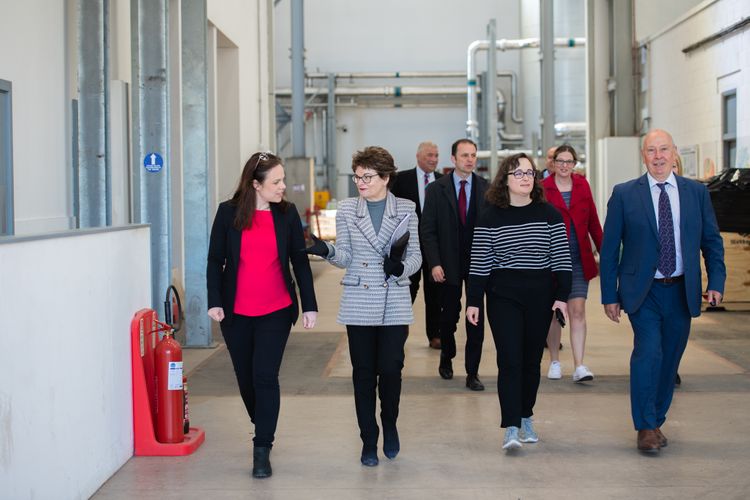Ambitious plans by the University of St Andrews to meet net zero targets, contribute to a just transition from fossil fuels, and take a leading role in driving a successful local and national economy were given the seal of approval this week when its new solar farm was unveiled by Cabinet Secretary for Finance and the Economy, Kate Forbes MSP, on a visit to its Eden Campus.
The one-megawatt ground solar photovoltaic (PV) development – backed by a Scottish Funding Council loan and supported by the Vacant & Derelict Land Fund from the Scottish Government and Fife Council – will provide electricity to the campus. This move further reduces the University’s overall carbon footprint by approximately 5%.
With a planned extension of its district heating network – which already pipes hot water from its award-winning £25 million biomass plant to 48 University buildings and 3000 student rooms in St Andrews – and the solar farm, the expectation is that the Eden Campus will be a carbon-neutral working environment within the next five years.
In addition to providing power to Walter Bower House and other buildings on the campus, the electrical supply will be utilised by electric vehicle charging points and the installation of battery storage.

Economy Secretary Kate Forbes said: “Scotland’s colleges and universities have a key role to play in rebuilding our economy and in helping Scotland meet its economic and climate goals in a way that is inclusive, as well as being beneficial on a local, national and international scale.
“The leadership shown by the University of St Andrews in transforming the Eden Campus into a vibrant centre of green innovation and job creation will ensure further opportunities for the University to harness green energy and drive inclusive growth in the local economy. I am honoured to be able to unveil the plaque for the Eden Campus Solar Farm today.
“These projects are not only an important step in the journey for the Eden Campus to become carbon neutral, but it is also an important step in helping Scotland meet the ambitious goal of being net zero by 2045.”

University Principal and Vice-Chancellor, Professor Sally Mapstone, said: “We are one of the world’s most ancient universities, but we strive to be one of the most modern and innovative. Social responsibility and sustainability are at the heart of our strategic plan. We are committed to a programme of decarbonisation, the efficient use of heat and water resources across our estate, as well as a deep-seated institutional commitment to all forms of environmental degradation by 2035, including through sustainable practice and policy.
“St Andrews is also at the heart of world-leading research into harnessing green energy, including the development of hydrogen trains, which has resulted in a strong relationship between the School of Chemistry and the Eden Campus as a scale-up site for research and development, as well as being the University’s front door for commercial collaboration with more than 100 companies engaging in the site since 2020.”
Watch a video on the opening of the solar array on YouTube.
Eden Campus
Following significant investment from the University, the UK and Scottish Governments, and many other partners, the former paper mill site is being transformed into a location where industry and academia can come powerfully together.
Further projects are planned as the Campus aims to drive forward the University’s plans to be carbon net zero by 2035. In addition to generating heat and electricity, the Campus aims to capture carbon and convert it into a range of valuable fuels and products.
This year, Eden Campus will become home to several spin-out companies working at the frontiers of science and technology – companies producing sustainable antibiotics, new fuel cells, synthetic proteins, and new batteries.